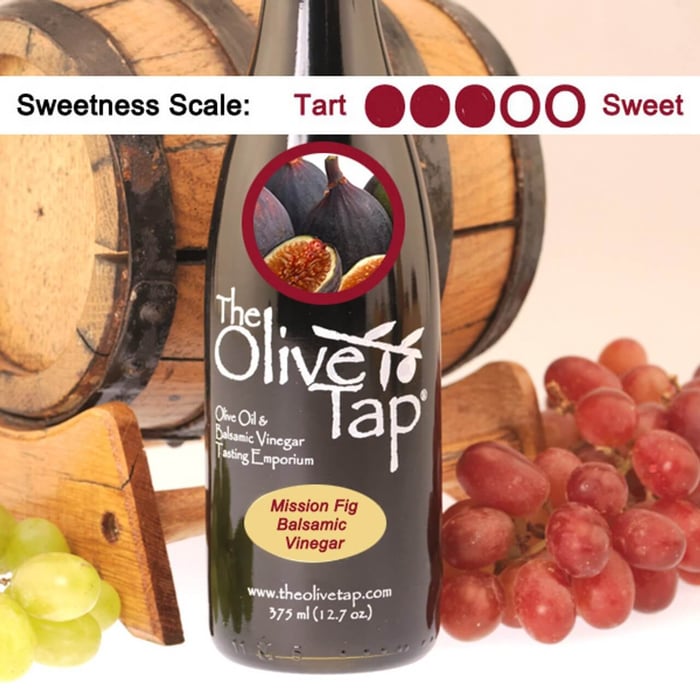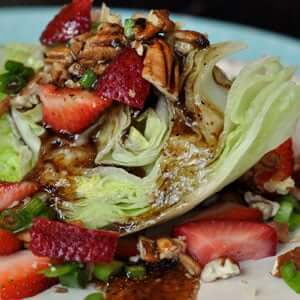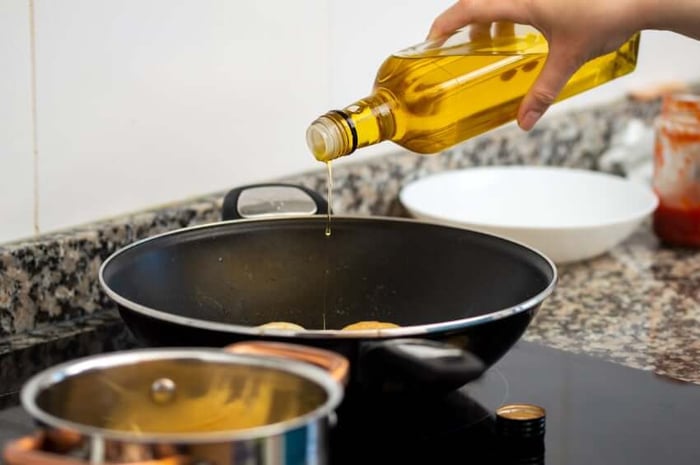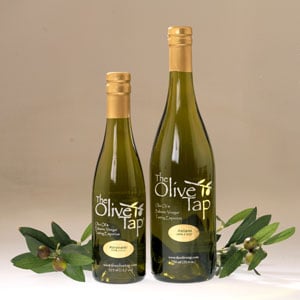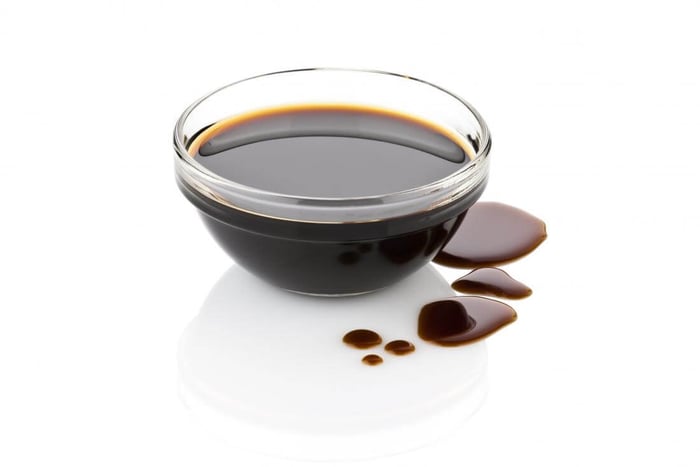Our Blog
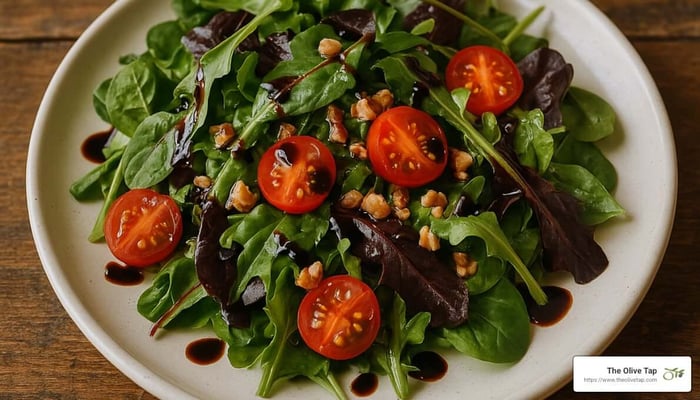
Will Balsamic Vinaigrette Make You Fat? The Honest Answer
Is Balsamic Vinaigrette Fattening? Here's the Quick, Honest Answer
Is Balsamic Vinaigrette fattening? In short: it depends. Traditional Balsamic Vinegar itself is extremely low-calorie (about 14 calories per tablespoon). But a Balsamic Vinaigrette—a dressing made from mixing vinegar with oils and sometimes sugars—has around 70–100 calories per tablespoon, mostly from fat.
Here's a quick breakdown to answer this clearly:
- Pure (Traditional) Balsamic Vinegar: 14 calories per tablespoon, 0g fat.
- Balsamic Vinaigrette (typical): 70–100 calories per tablespoon, 6–10 grams fat.
So, Balsamic Vinaigrette can add calories quickly if you're not paying attention to servings. But it isn't inherently unhealthy. In fact, many vinaigrettes contain beneficial fats that help your body absorb nutrients from salad greens and other veggies.
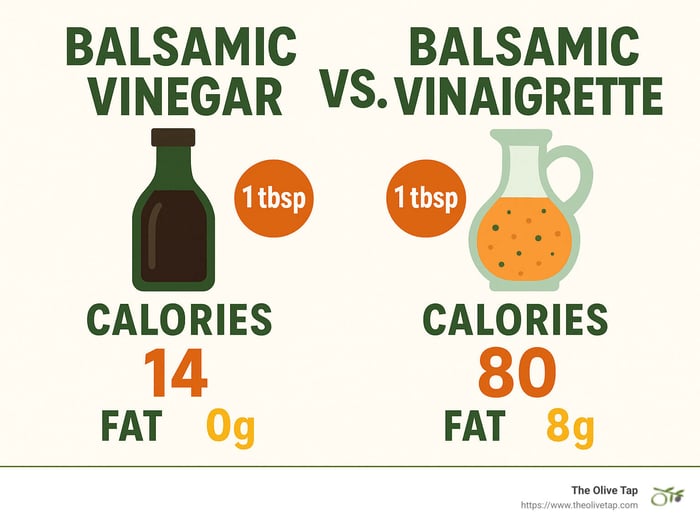 Understanding Balsamic Vinaigrette: What's Actually In It?
Understanding Balsamic Vinaigrette: What's Actually In It?
Before we can answer whether is Balsamic Vinaigrette fattening, we need to understand what's in your bottle or homemade mix. The difference between Pure (Traditional) Balsamic Vinegar and vinaigrette is night and day when it comes to your waistline—and this distinction matters for anyone watching their calories.
When you drizzle that dark, flavorful vinaigrette on your salad, you're typically enjoying a mixture of:
- Balsamic Vinegar (the tangy, sweet base)
- Olive Oil (usually making up the majority—in ratios from 1:2 to 1:3 vinegar to oil)
- Emulsifiers like Dijon mustard or a touch of honey (these help the oil and vinegar become friends instead of separating)
- Seasonings that bring everything to life (garlic, herbs, salt, pepper)
- Sometimes additional sweeteners (like a spoonful of maple syrup or honey)
What's in your vinaigrette makes all the difference. A bottled dressing from the supermarket shelf might be worlds apart from what we recommend making with our premium ingredients including Extra Virgin Olive Oils, Flavor Infused Oils and Balsamic Vinegars at The Olive Tap. When you create your own quality vinaigrette using our aged balsamic vinegars and freshly-pressed olive oils, you control exactly what goes into your food. Note: Nutritional Information is generalize for purposes of this article. See The Olive Tap's specific Nutritional Information.
| Component | Balsamic Vinegar (1 Tbsp) | Balsamic Vinaigrette (1 Tbsp) |
|---|---|---|
| Calories | 14 | 70-100 |
| Fat | 0g | 6-10g |
| Carbs | 2.7g | 3-5g |
| Sugar | 2.4g | 2-4g |
| Sodium | 5mg | 100-300mg |
This comparison tells the story quite clearly. The change from just vinegar to vinaigrette adds significant calories and fat—which answers part of why people wonder is balsamic vinaigrette fattening. It's certainly more calorie-dense than the straight vinegar alone.
The Difference Between Balsamic Vinegar and Balsamic Vinaigrette
I can't tell you how many times customers confuse these two products, so let's clear this up once and for all.
Balsamic Vinegar is a culinary treasure originating from Italy, the Modena Region specifically. It is now produced in many global regions today. Traditional Balsamic Vinegar is made from trebbiano and lambrusco grapes and crushed into what is known as grape must. This grape must is slowly cooked down, then aged patiently in wooden barrels, sometimes for decades. The result? A complex, sweet-tart flavor with virtually no fat and minimal calories. To learn more on how Balsamic Vinegar is made, including learning about the types of "grades", please checkout our blog article Balsamic Vinegar of Modena, Traditionale & Condimento Grades.
As Judy Caplan, a registered dietitian, notes: "Balsamic vinegar contains no fat and very little natural sugar. It's been proven to lower cholesterol, stabilize blood pressure, support weight loss, and improve your skin."
Balsamic Vinaigrette, on the other hand, is what happens when you take that wonderful vinegar and blend it with olive oil and other ingredients to create a what some call a salad dressing but is technically a Balsamic Vinaigrette. While it keeps some of that distinctive tang and potential health benefits, the addition of oil significantly changes its nutritional profile and taste.
Charlotte Martin, MS, RDN, puts it well: "Balsamic Vinaigrette has a hint of sweetness with little to no added sugar and is packed with heart-healthy unsaturated fats." This highlights something important—yes, vinaigrette contains fat, but it's often the beneficial kind that supports your overall health.
Charlotte is absolutely correct, however the quality of the added ingredients is key to making a healthy Balsamic Vinaigrette.
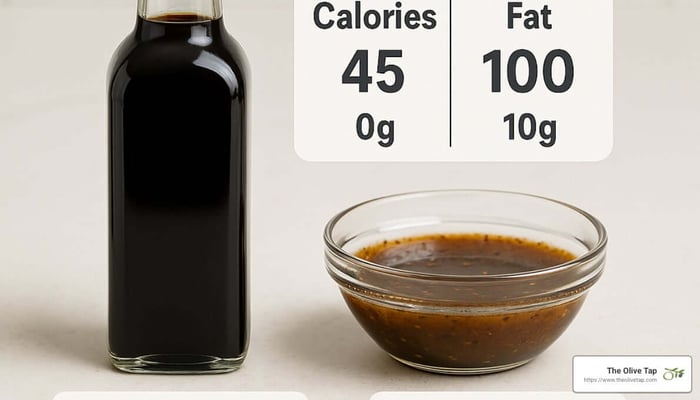
Common Ingredients That Can Make Balsamic Vinaigrette More Fattening
Not all vinaigrettes deserve equal praise. Some store-bought versions can sneak in extra calories through ingredients you might not expect:
Added Sugars can pile on empty calories. While traditional honey mustard vinaigrette might contain around 5g of sugar in 2 tablespoons, more health-conscious versions might have just 2g. That difference adds up over time.
Thickeners and Stabilizers like xanthan gum and modified food starch don't directly add many calories, but they create that creamy texture that tempts you to pour more. Before you know it, your "just a drizzle" becomes two or three servings. In addition, these ingredients are not natural or truly necessary.
Preservatives and Flavor Improvers might not add calories directly, but they can mask the taste of lower-quality ingredients. This often means you're consuming more of a less nutritious product with unnecessary added ingredients, which isn't doing your waistline any favors.
Lower-Quality Oils in many commercial brands replace heart-healthy olive oil (quality Extra Virgin Olive Oil - aka EVOO) with cheaper vegetable oils. As Mary Stewart, RD, explains: "Most Americans get too many omega-6 fatty acids in their diets, and not enough omega-3 fatty acids. This imbalance can increase inflammation in the body and lead to obesity."
This is why at The Olive Tap, we always encourage making your own vinaigrette with our premium Balsamic Vinegar Products. When you start with exceptional ingredients, even the simplest vinaigrette (dressing) becomes extraordinary—and you control exactly what goes into your body. Our customers often tell us they use less dressing overall when it's made with our flavorful products, which naturally helps with portion control.
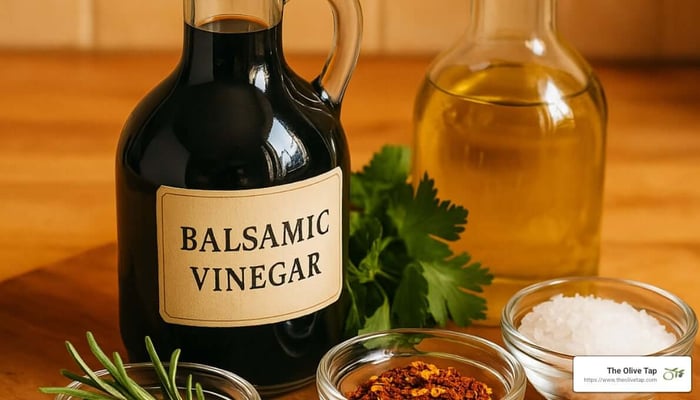
Knowing what's in your vinaigrette is the first step toward making smarter choices. The good news? You can enjoy the rich flavors of balsamic without worrying about your weight—it just takes a bit of knowledge and the right approach. And speaking of health benefits, our premium balsamic vinegars offer more than just flavor—they come with an array of Health Benefits of Balsamic Vinegar that make them worth incorporating into your diet, regardless of calorie concerns.
Is Balsamic Vinaigrette Fattening? The Nutritional Breakdown
Okay, let's dive right into what you're really wondering: is balsamic vinaigrette fattening? To truly answer this, we need to look closely at the nutritional details of your favorite salad dressing.
A typical serving of balsamic vinaigrette—about two tablespoons (30 grams)—has around 100 to 120 calories. Most of these calories (around 88%) come from fat, and about 12% from carbohydrates. There's little to no protein involved here.
A quick breakdown of those two tablespoons usually looks something like this:
- Calories: 100-120
- Total Fat: 10-12 grams (mostly healthy fats if made with olive oil)
- Carbs: 3-5 grams (including around 2-4 grams of sugar)
- Protein: less than 1 gram (pretty much zero)
- Sodium: around 200-300 mg (varies by brand and recipe)
Now you might think, "Wait, that's quite a bit of fat! Is that a bad thing?"
Actually, not necessarily. With quality ingredients, like the extra virgin olive oils we love at The Olive Tap, most of these fats are monounsaturated—the good kind. These heart-healthy fats can lower cholesterol and might even help you maintain or lose weight when eaten thoughtfully. So the answer to "is balsamic vinaigrette fattening" isn't just about calories—it's also about the kind of fats you're getting.
Research even hints at some exciting possibilities. A scientific study found certain compounds in Balsamic Vinegar might help fight obesity.
Calorie Content: How Balsamic Vinaigrette Compares to Other Dressings
To really understand if balsamic vinaigrette is fattening, let's compare it to other popular dressings. If you're picturing ranch or blue cheese dressing right now—spoiler alert—Balsamic Vinaigrette is lower in calories!
A typical serving (two tablespoons) of creamy dressings like Ranch or Caesar usually comes with about 140-180 calories. Blue Cheese and Thousand Island aren't far behind, with about 120-170 calories. Italian Dressing hovers around 80-120 calories. And Yogurt-based Dressings are usually lower, around 35-70 calories.
Here's where our friend, Balsamic Vinaigrette, sits comfortably in the middle at 100-120 calories per serving. Switching from Ranch or Caesar to a tasty, quality Balsamic Vinaigrette can easily save you calories while keeping your salads flavorful, satisfying and nutritious.
Just remember, as dietitian Lauren Harris-Pincus puts it: "The key is portion control—any dressing can become high-calorie if you're using too much."
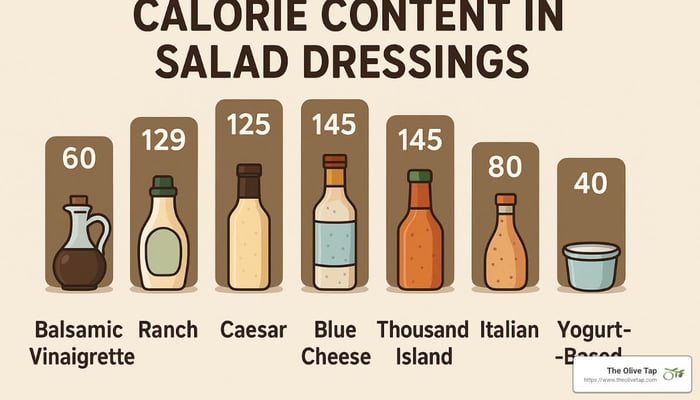
Fat Content in Balsamic Vinaigrette: Good Fats vs. Bad Fats
Yes, there's fat in balsamic vinaigrette—but let's not panic. The type of fat matters a lot. When you use high-quality Extra Virgin Olive Oil (like the EVOOs you'll find at The Olive Tap), these fats are primarily monounsaturated, known as "good fats."
Why are these good fats important? Monounsaturated fats help protect your heart by lowering bad cholesterol (LDL) and supporting good cholesterol (HDL). They're also associated with healthier weight management because they help you feel full and satisfied longer. This means less mindless snacking later—sounds good to me!
Adding healthy fats to your salad actually helps you absorb vital nutrients, like vitamins A, D, E, and K. As Charlotte Martin, MS, RDN says, "We want healthy fat in our salads to get the most from all those leafy greens and veggies."
And the research backs it up. A study published in the American Journal of Clinical Nutrition found that adding a moderate amount of good fat to your salad increases how well your body absorbs helpful plant nutrients (carotenoids, anyone?).
Bottom line? If you're asking "is balsamic vinaigrette fattening," the answer lies in the details. Quality ingredients and mindful portions are key. A delicious vinaigrette made with quality balsamic vinegar and extra virgin olive oil isn't just tasty—it's good for you too.
How Balsamic Vinaigrette Affects Your Weight Management Goals
We get it and you might still be wondering, is balsamic vinaigrette fattening? The truth is, it really depends on how you use it within your overall diet and lifestyle. Let's explore exactly how balsamic vinaigrette impacts your weight management efforts—and how to enjoy it without worry.
First off, let's talk about portion control. Balsamic Vinaigrette packs a lot of flavor, meaning a little goes a long way. A typical serving size is just 2 tablespoons (about 100–120 calories), which is plenty to cover a medium-sized salad. But it's easy to accidentally pour more—especially at restaurants, where salad dressings often come in generous portions on the side. Being mindful of portions, whether eating at home or dining out, can make a significant difference in your daily calorie intake.
Another important concept to understand is calorie density. At around 50–60 calories per tablespoon, balsamic vinaigrette is relatively calorie-rich. This means that even small increases in portion size can quickly add up in terms of calories. If you're working to manage your weight, keeping an eye on serving sizes can help keep your calorie budget in check.
That said, Balsamic Vinaigrette comes with some clear advantages that support weight management. Because it's flavorful and tangy, it helps boost the appeal of nutritious foods like fresh veggies and salads. Honestly, you're far more likely to eat (and enjoy!) a big bowl of greens and veggies when they're topped with a delicious vinaigrette rather than eaten plain. This improved flavor can help you stick to healthier eating habits long-term, ultimately supporting a healthy weight.
Interestingly, research suggests that the acetic acid in balsamic vinegar may offer metabolic benefits. It can help stabilize blood sugar levels, which may reduce cravings and even curb your appetite. As Kelsey Lorencz, RD, says, "The healthy fats in vinaigrettes will help keep you fuller longer, making your salad that much more satisfying." This satisfaction factor is key—you're less likely to snack or overeat later if your salad actually fills you up.
Is Balsamic Vinaigrette Good for Weight Loss?
When used mindfully, quality Balsamic Vinaigrette can be a fantastic ally in your weight loss journey. For starters, it's typically a lighter option compared to creamy, higher-calorie dressings like Ranch or Blue Cheese. Switching to Balsamic Vinaigrette from these heavier options can save you calories and fat overall.
Another great point: the healthy fats (EVOOs) in vinaigrette, especially when made with quality olive oil from The Olive Tap, help your body better absorb important nutrients from your salad veggies. Research backs this up, showing that pairing veggies with a moderate amount of healthy fat improves the absorption of vitamins like A, D, E, K, and beneficial plant nutrients called carotenoids.
And let's not forget flavor! Let's face it—you're much more likely to stick with healthy eating choices if they genuinely taste good. Balsamic Vinaigrette's balance of sweet and tangy notes makes it a delicious way to enjoy salads regularly.
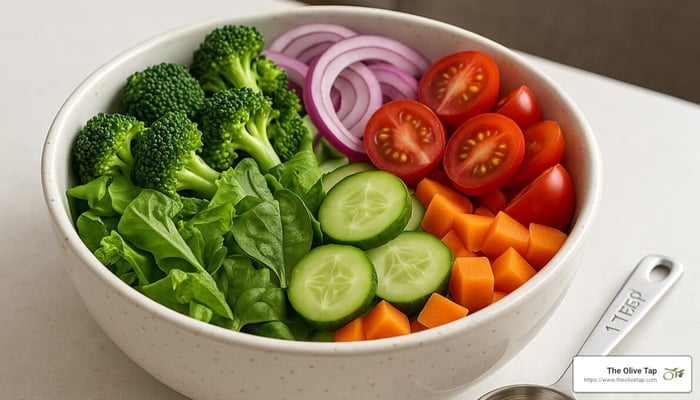
But remember, moderation is key. Measuring your dressing (yes, even vinaigrettes) rather than eye-balling helps ensure you're getting the flavor you love without consuming unwanted extra calories. Many dietitians, like Melissa Joy Dobbins, RD, recommend choosing oil and vinegar-based dressings and keeping portions under control for the best results.
How Much Balsamic Vinaigrette Is Too Much?
Since we've established that balsamic vinaigrette isn't inherently "fattening," but it can add calories quickly, it's natural to wonder exactly how much is too much.
A standard serving size of balsamic vinaigrette is about 2 tablespoons (30g), clocking in at about 100–120 calories. To visualize this amount, think of roughly the size of your thumb—or two thumb-sized portions—to dress your salad.
If measuring exactly isn't convenient, you can try the "dip method." Instead of pouring dressing directly onto your salad, dip your fork into the dressing before each bite. You'll get the same flavorful experience while using significantly less dressing overall.
And while there's no strict weekly limit, be cautious if you're having salads multiple times per day. Dressing calories can sneak up quickly, making it easy to unintentionally exceed your calorie goals. Also, keep in mind that restaurant and take-out salad dressings tend to come in much larger servings than you'd expect—often two or three times the recommended amount. Always ask for your dressing on the side, so you can control exactly how much you use.
To sum it up: Balsamic Vinaigrette can absolutely be part of a successful weight management plan. The key is mindful consumption, portion awareness, and choosing high-quality ingredients—like The Olive Tap’s freshly-pressed olive oils and aged balsamic vinegars—to maximize nutrition and enjoyment.
Healthier Alternatives and Modifications to Traditional Balsamic Vinaigrette
If you're asking yourself, "is balsamic vinaigrette fattening?", you're probably wondering how to enjoy its delicious flavor without worrying too much about calories. The good news is there are simple ways to lighten up this classic dressing and still savor its rich, tangy goodness.
One easy trick is adjusting the ratio of vinegar to oil. Most traditional recipes use a 1:3 vinegar-to-oil ratio, which can pack in extra calories from the oil. Shifting to a lighter 1:2 or even a 1:1 mix can significantly reduce calories and fat without compromising on flavor.
Another delicious and healthy option is making a creamy yogurt-based balsamic dressing at home. Charlotte Martin, MS, RDN, recommends this smart swap: "Yogurt-based dressings give you the best of both worlds—creamy texture with fewer calories." To whip up your own, simply blend Greek yogurt with a splash of quality balsamic vinegar and a drizzle of extra virgin olive oil. You'll get a creamy, flavorful dressing that's lighter than store-bought creamy varieties. See Mario's Yogurt Lime Dressing Recipe.
Adding a splash of water to your homemade vinaigrette is also surprisingly effective. This little addition helps maintain volume and consistency, letting you cut down on oil without losing that smooth texture you love.
But if you're really keeping a close eye on calories, consider skipping the oil altogether and enjoying pure aged balsamic vinegar instead. Premium aged balsamic vinegars from The Olive Tap have an incredible depth of flavor and natural sweetness, making them perfect drizzled straight onto salads, fresh veggies, or fruits—even without oil.
Another flavorful and low-calorie alternative is making a balsamic glaze or reduction. By gently simmering balsamic vinegar until it reduces by half, you'll create a thicker, sweeter syrup-like consistency. This concentrated glaze allows you to use just a small amount for a big flavor impact, keeping your calorie count low.
As Lauren Harris-Pincus, MS, RDN, suggests, watching added sugar is important too: "Those looking to follow a lower-carb plan or reduce added sugars should avoid dressings like Honey Mustard, Thousand Island, French or Catalina. It's best to stick with a quality balsamic vinaigrette instead." Check out our many Vinaigrette Recipes.
Creating a Lighter Balsamic Vinaigrette at Home
Making your own lighter balsamic vinaigrette is easier than you might think. Not only does it allow full control over ingredients, it's also budget-friendly and tastier than most store-bought options! Here's a simple recipe you can whip up in minutes:
Lighter Balsamic Vinaigrette Recipe:
- 2 tablespoons premium balsamic vinegar (try one from The Olive Tap for best flavor)
- 2 tablespoons extra virgin olive oil (instead of the traditional 3-4 tablespoons)
- 1 teaspoon Dijon mustard (helps emulsify and adds flavor without extra fat)
- 1 small garlic clove, minced (optional but tasty!)
- 1 teaspoon honey or maple syrup (optional for sweetness)
- Salt and freshly ground pepper to taste
- 1 tablespoon water (helps keep the texture light)
Just combine all ingredients in a bowl or jar, whisking vigorously (or shaking) until smooth and creamy. This lightened-up version has around 60–70 calories per tablespoon, compared to 80–100 calories in traditional recipes.
Store your homemade vinaigrette in a sealed jar in the fridge for up to a week. Don't worry if the olive oil solidifies slightly when cold; just let it sit at room temperature for a few minutes and give it a good shake before serving.
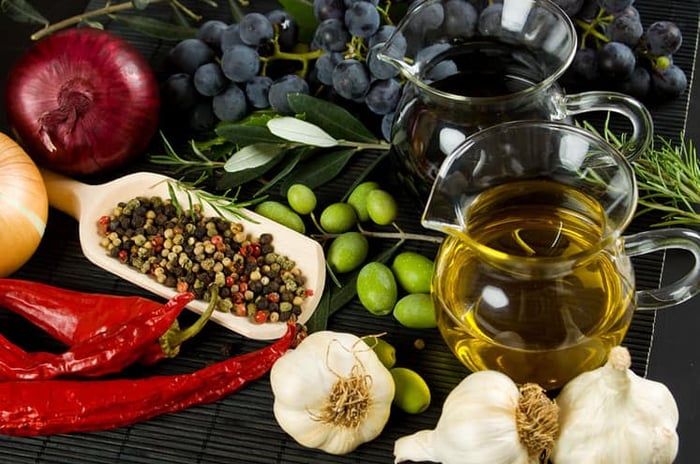 Use Quality Balsamic Vinegar, EVOO & More for a Healthy & Flavorful Vinaigrette
Use Quality Balsamic Vinegar, EVOO & More for a Healthy & Flavorful VinaigretteSmart Ways to Enjoy Balsamic Flavor Without the Extra Calories
If you're looking to cut back even more, there are plenty of clever ways to enjoy balsamic flavor with minimal calories. Our premium aged balsamic vinegars at The Olive Tap offer naturally complex flavors and sweetness, making them ideal for calorie-conscious eating. Just a drizzle of pure balsamic over fresh tomatoes, ripe peaches, or roasted veggies adds amazing taste without the extra calories from oil.
Another customer favorite is balsamic glaze—simply simmer balsamic vinegar until it's thick and syrupy (usually about half its original volume). A little drizzle of this glaze over salads, grilled chicken, or roasted veggies packs powerful flavor into fewer calories. As our FAQ explains: "Select your preferred vinegar, add it to a saucepan, and simmer gently until reduced by about half, typically within 10–15 minutes."
At The Olive Tap, you'll also find a delightful variety of flavored balsamic vinegars like Mission Fig, Raspberry, or Bourbon Maple. A small splash of these infused vinegars can transform a simple meal into something special without adding fat or extra calories.
To get even more flavor from less vinegar, try the "spritz method." Simply pour vinegar into a small spray bottle and lightly mist over salads or grilled veggies. You'll get perfectly even coverage with only a tiny amount of vinegar.
As one of our happy customers shared: "The Blood Orange Olive Oil and Fig Balsamic from The Olive Tap are the most versatile staples in my pantry. They're delicious on salads, fish, pork, and even roasted veggies—my guests always rave about them!"
With these simple tips and tasty options, you don't have to wonder if balsamic vinaigrette is fattening anymore. You can confidently enjoy its flavor in ways that fit your health, diet, and taste buds.
If you are looking to get started today, and experience a wide variety of vinaigrette combinations, we offer Our Tour of Italy Sampler or more Samplers. There not just for gifts but a great way to create vinaigrettes at an affordable price. Simply mix and match based on your taste preferences or check out Our Perfect Pairings for flavorful combinations.
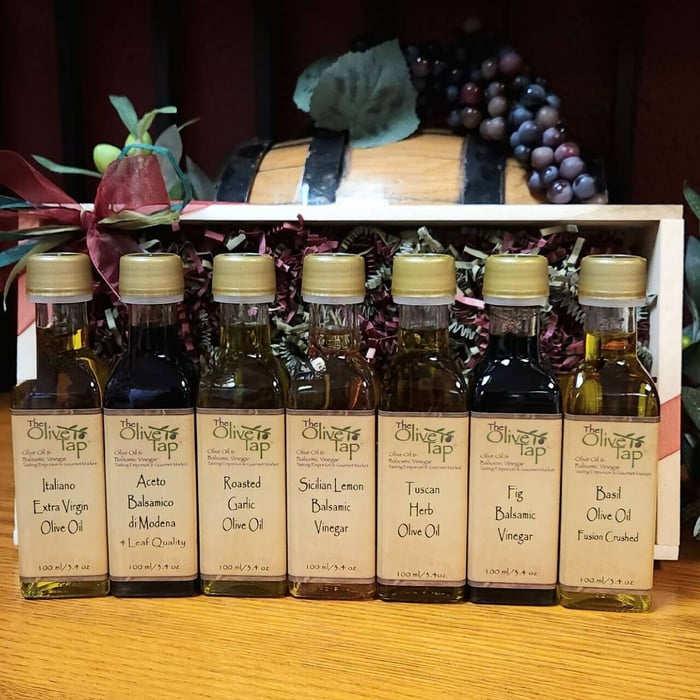 Our Tour of Italy Sampler
Our Tour of Italy Sampler
Frequently Asked Questions About Balsamic Vinaigrette and Weight Gain
When it comes to salad dressings (or vinaigrettes in this case), we often hear the same common questions at The Olive Tap. Customers love the flavor of balsamic vinaigrette but worry about their waistlines. Let's set the record straight and answer your burning questions, warmly and honestly!
FAQs
Will balsamic vinaigrette make me gain weight?
This is probably the top question we get: is balsamic vinaigrette fattening? Well, here's the good news: balsamic vinaigrette itself won't cause weight gain—unless you go overboard. Like any dressing, it has calories, typically around 100–120 per two tablespoons. But enjoying it in moderation, as part of a balanced diet, won't tip the scale.
To keep things in check, simply measure your portions rather than eyeballing them. A little mindfulness goes a long way!
Is store-bought or homemade balsamic vinaigrette healthier?
We always recommend making your own dressing when you can. Homemade balsamic vinaigrette lets you control exactly what's going into your salad. Many store-bought versions contain preservatives, unnatural ingredients, extra salt, or added sugars. Although high-quality commercial options are available, they often aren't as pure or fresh as homemade.
By whipping up your own vinaigrette—like the lighter homemade vinaigrette recipe—you can choose premium ingredients, cut down on unnecessary additives, and tailor the flavor to your personal taste. Plus, it's surprisingly easy!
Is fat-free balsamic vinaigrette a better option?
Fat-free dressings might seem like a smart choice at first glance, but they're not always better. Why? Because healthy fats actually play a crucial role in helping your body absorb important nutrients from salad greens and veggies. Charlotte Martin, MS, RDN, says: "We want some healthy fat in our salad dressing. Fat helps us absorb fat-soluble vitamins (vitamins A, D, E and K) found in produce."
What's more, when manufacturers remove fat, they often add extra sugar, salt, or artificial ingredients to boost flavor. So a fat-free dressing isn't always the healthiest—or most satisfying—choice. Instead, stick with moderate portions of a tasty vinaigrette made with high-quality olive oil and balsamic vinegar, like the products we proudly offer at The Olive Tap.
How can I reduce the calories in balsamic vinaigrette without sacrificing flavor?
You don't have to sacrifice flavor in order to enjoy lighter vinaigrette! Try experimenting with the vinegar-to-oil ratio—using a bit more vinegar and less oil is a simple calorie-cutting method. Adding a small amount of water can also thin out your dressing without losing flavor.
For more taste, incorporate fresh herbs, garlic, or spices, and consider using Dijon mustard as an emulsifier to help keep the dressing creamy with less oil. Your taste buds (and your waistline) will thank you!
Does Balsamic Vinaigrette Have Health Benefits Despite Its Calorie Content?
Absolutely! Even though people often worry about is balsamic vinaigrette fattening, the truth is this tasty dressing actually has numerous health benefits:
Balsamic vinegar contains antioxidants called polyphenols, which help reduce inflammation and oxidative stress. Research published in the Journal of Nutritional Science and Vitaminology suggests that vinegar's acetic acid may even help regulate blood sugar and improve insulin sensitivity—both helpful for weight control.
The olive oil used in vinaigrettes provides monounsaturated fats, known for supporting heart health and lowering bad cholesterol levels. Additionally, balsamic vinegar supports digestion thanks to its probiotic qualities, helping maintain a healthy gut.
As dietitian Judy Caplan notes, balsamic vinegar can even help "lower cholesterol, stabilize blood pressure, support weight loss, and improve your skin." That's a pretty impressive list of perks for such a delicious dressing!
Can I Eat Balsamic Vinaigrette Every Day Without Gaining Weight?
Yes—if you're mindful! Eating balsamic vinaigrette daily won't automatically lead to weight gain, especially if you practice careful portion control. Stick to about 1–2 tablespoons per salad, and make sure your overall diet remains balanced.
Choosing high-quality ingredients matters too. Premium balsamic vinegars and extra virgin olive oils, like those at The Olive Tap, deliver better flavor and nutritional quality, so you'll feel more satisfied with less dressing.
Don't forget that a physically active lifestyle helps balance calorie intake and supports overall health. With mindful eating, quality ingredients, and regular activity, daily enjoyment of balsamic vinaigrette is absolutely doable.
What's The Best Way to Measure Balsamic Vinaigrette for Weight Management?
To keep track of calories, it's helpful to measure vinaigrette precisely. The easiest method? Use measuring spoons. A standard portion is 1–2 tablespoons per salad—that's roughly 15–30 grams if you're using a food scale.
If you don't have measuring tools handy, you can rely on visual guides. One tablespoon is roughly the size of your thumb tip up to the first joint. Two tablespoons is about the size of a ping-pong ball or golf ball.
Dining out? Dressing portions at restaurants tend to be generous—often triple the recommended serving size! Instead of pouring it all on your salad, use the clever "fork dip" method: dip your fork into the dressing first, then spear your salad. You'll get all the flavor you love with fewer calories.
With these simple tips, you can confidently enjoy delicious salads dressed with quality balsamic vinaigrette—completely worry-free!
Conclusion
So, is balsamic vinaigrette fattening? As we've found, the answer isn't as straightforward as a simple "yes" or "no." Like most delicious foods, the impact on your weight truly depends on how much you use, what you're swapping it in for, and your overall lifestyle.
Balsamic Vinaigrette does contain calories—around 50–60 per tablespoon, making it calorie-dense compared to plain balsamic vinegar. But before you swear it off entirely, these calories primarily come from heart-healthy monounsaturated fats, especially when you choose a vinaigrette made with high-quality olive oil. At The Olive Tap, we believe in using premium, freshly-pressed olive oils that taste amazing and offer plenty of nutritional benefits.
The secret to enjoying balsamic vinaigrette without tipping the calorie scales lies in mindful portion control. Stick to the standard serving size of about 2 tablespoons per salad, and you'll get all the flavor you crave without overdoing it on calories.
Quality ingredients make a big difference, too. When you use top-notch products—like the premium aged balsamic vinegars and genuine olive oils we provide at The Olive Tap—you'll find you don't need as much to satisfy your taste buds. A little goes a long way!
If you're especially calorie-conscious, you can easily tweak traditional vinaigrette recipes at home. Simply use less olive oil, add a splash of water, or try pure aged balsamic vinegar or a homemade balsamic glaze for intense flavor without extra calories.
And let's not forget, along with its delightful taste, balsamic vinaigrette offers meaningful health benefits. With antioxidants from the vinegar and beneficial fats from high-quality olive oil, it can be a nutritious addition to your diet when enjoyed in moderation. Research even highlights balsamic vinegar's positive effects on blood sugar regulation, heart health, and digestion.
Here at The Olive Tap, we're passionate about providing only the best artisan products, crafted to lift your meals and nourish your body. Whether you're drizzling our aged balsamic vinegar over a salad, mixing up your own perfect vinaigrette at home, or exploring lighter alternatives, quality and moderation are key.
Ready to find the difference premium ingredients can make? Visit us at our convenient locations in Colorado Springs, Crystal Lake Illinois, Manitou Springs Colorado, Medina Ohio, or Pittsburgh Pennsylvania—or explore our award-winning selections online at The Olive Tap. We're here to help you make healthy eating an enjoyable, flavorful trip.

